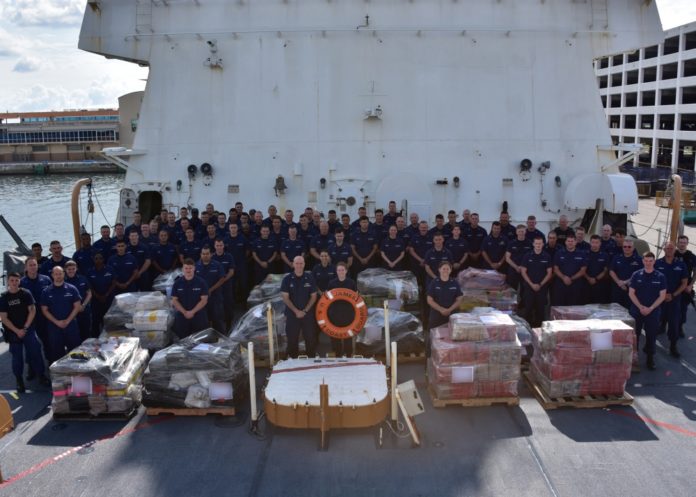
MIAMI — The crew of the Coast Guard Cutter James offloaded approximately 6 tons of cocaine, Thursday, in Port Everglades worth an estimated $180 million seized in international waters in the Eastern Pacific Ocean.
The drugs represent six separate suspected drug smuggling vessel interdictions off the coasts of Central and South America, and Mexico by three Coast Guard cutters between late February and mid-April.
– The Coast Guard Cutter Bertholf was responsible for one case, seizing an estimated 1,653 pounds of cocaine.
– The Coast Guard Cutter Bear was responsible for two cases, seizing an estimated 6,029 pounds of cocaine.
– The Coast Guard Cutter James was responsible for three cases, seizing an estimated 4,313 pounds of cocaine.
“The James deployed to the eastern Pacific Ocean for a 20-day period and interdicted over 2,000 kilograms of cocaine from three separate vessels reflecting the significant amount of illicit contraband heading towards the United States on a daily basis,” said Capt. Mark Fedor, commanding officer the cutter James. “ The U.S. Coast Guard works with other U.S. agencies and law enforcement officials from partner nations in the regionresulting in the seizure of thousands kilograms of cocaine every year. Each successful interdiction is another successful step towards protecting our respective borders and citizens from the rising threat of transnational criminal organizations.”
The Coast Guard increased the U.S. and allied presence in the Eastern Pacific Ocean and Caribbean Basin, which are known drug transit zones off of Central and South America, as part of its Western Hemisphere Strategy. During at-sea interdictions in international waters, a suspect vessel is initially located and tracked by allied, military or law enforcement personnel. The interdictions, including the actual boarding, are led and conducted by U.S. Coast Guardsmen. The law enforcement phase of counter-smuggling operations in the Eastern Pacific is conducted under the authority of the Coast Guard 11th District headquartered in Alameda, California.
Numerous U.S. agencies from the Departments of Defense, Justice and Homeland Security are involved in the effort to combat transnational organized crime. The Coast Guard, Navy, Customs and Border Protection, FBI, Drug Enforcement Administration, and Immigration and Customs Enforcement along with allied and international partner agencies play a role in counter-drug operations. The fight against transnational organized crime networks in the Eastern Pacific requires unity of effort in all phases from detection, monitoring, and interdictions to prosecutions by several U.S. Attorneys’ offices around the nation and authorities in partner nations.
The cutter James is a 418-foot national security cutter homeported in North Charleston, South Carolina.

